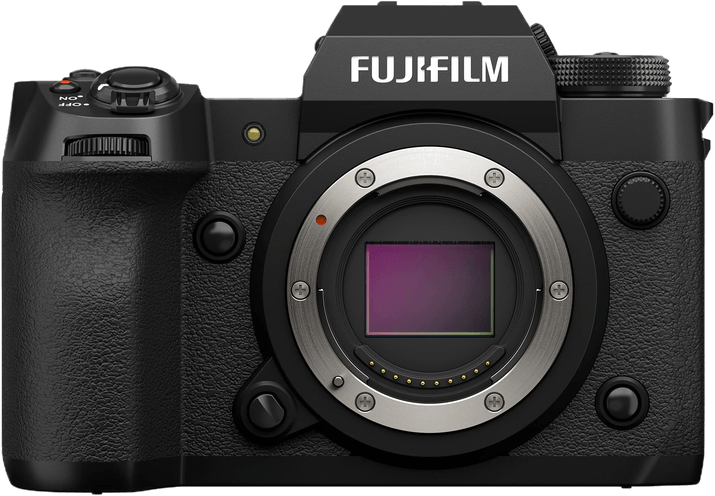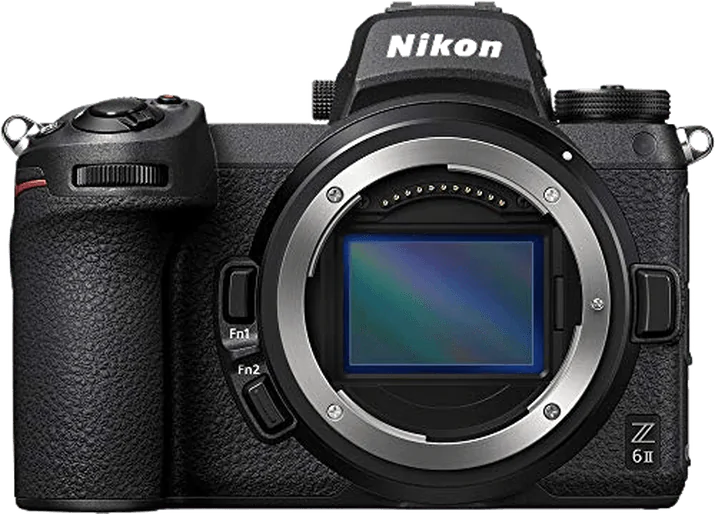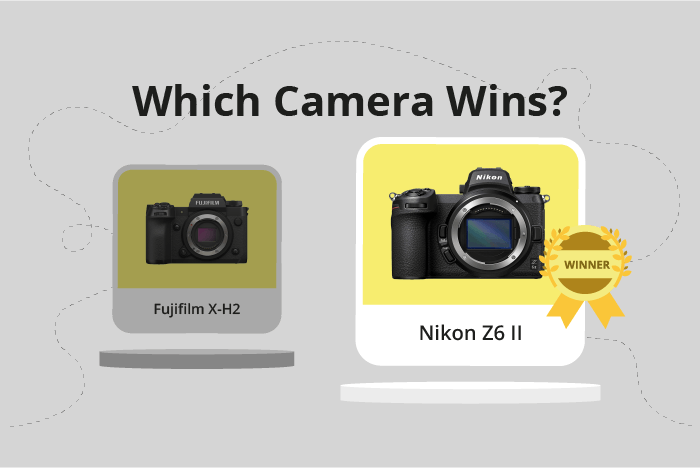Fujifilm X-H2 vs Nikon Z6 II Comparison
Fujifilm X-H2

Nikon Z6 II

The Nikon Z6 II edges out the Fujifilm X-H2 by just one point, with scores of 83/100 and 82/100, respectively. Both cameras are mirrorless and were launched at similar price points: $1995 for the Nikon Z6 II and $1999 for the Fujifilm X-H2. They share similar dimensions, with the Nikon Z6 II being slightly smaller at 134 x 101 x 70mm, compared to the Fujifilm X-H2’s 136 x 93 x 95mm. However, the Fujifilm X-H2 is lighter, weighing 660g (1.46lbs), while the Nikon Z6 II weighs 705g (1.55lbs).
The winning Nikon Z6 II benefits from its earlier release in 2020, allowing it to establish a strong reputation among photographers. On the other hand, the Fujifilm X-H2, released in 2022, offers the advantage of being a more recent model, potentially featuring the latest technology and improvements.
Despite the close scores, the Nikon Z6 II’s slight edge in size and established reputation make it a popular choice among photographers. However, the Fujifilm X-H2’s lighter weight and newer release could appeal to those seeking the latest advancements in camera technology. Ultimately, both cameras have their merits, and the choice depends on individual preferences and priorities.
Fujifilm X-H2 vs Nikon Z6 II Overview and Optics
The Nikon Z6 II takes the lead in optics with a score of 83/100, while the Fujifilm X-H2 follows closely with a score of 81/100. Both cameras share common specifications such as CMOS sensor type, image stabilization, and lens mounts specific to their respective brands.
The Fujifilm X-H2 boasts a higher megapixel count at 40, compared to the Nikon Z6 II’s 24.5 megapixels. This results in better resolution and detail in images captured by the X-H2. Additionally, the X-H2 has a faster shooting speed of 15 frames per second (fps), slightly outperforming the Nikon Z6 II’s 14 fps. The Fujifilm X-H2 also features the X-Processor 5, which contributes to its overall performance.
On the other hand, the Nikon Z6 II has a full-frame sensor, which provides a larger sensor area than the Fujifilm X-H2’s APS-C sensor. This allows the Nikon Z6 II to perform better in low light conditions and achieve a shallower depth of field. The Nikon Z6 II also has a DXOMARK score of 94 for its sensor, indicating its excellent image quality. The dual Expeed 6 processors in the Nikon Z6 II enable faster processing and better performance.
Despite the Fujifilm X-H2’s higher megapixel count and shooting speed, the Nikon Z6 II’s full-frame sensor and higher DXOMARK score make it the better option in terms of optics. The larger sensor size and better image quality give the Nikon Z6 II an edge over the Fujifilm X-H2. However, the Fujifilm X-H2 is still an excellent choice for those who prioritize resolution and shooting speed.
Fujifilm X-H2 vs Nikon Z6 II Video Performance
The Nikon Z6 II outperforms the Fujifilm X-H2 in video capabilities with a score of 91/100 compared to the X-H2’s score of 83/100. Both cameras share some common video specifications, such as 4K maximum video resolution and 3840 x 2160 maximum video dimensions. Additionally, both cameras have built-in time-lapse functionality.
The Nikon Z6 II surpasses the Fujifilm X-H2 in video performance primarily due to its higher maximum video frame rate of 120fps, while the X-H2 offers a maximum of 60fps. This higher frame rate allows the Z6 II to capture smoother slow-motion footage and provides more flexibility for videographers in post-production.
The Fujifilm X-H2, although scoring lower than the Nikon Z6 II, still offers solid video capabilities with its 4K resolution and 60fps maximum frame rate. These features are suitable for most videography needs, but the camera does not provide any significant advantages over the Nikon Z6 II in this regard.
Taking these factors into consideration, the Nikon Z6 II is the superior choice for videographers due to its higher video score and more advanced features, such as the 120fps maximum frame rate. The Fujifilm X-H2 remains a viable option for those who do not require the additional frame rate capabilities but still seek a camera with 4K video resolution and time-lapse functionality.
Fujifilm X-H2 vs Nikon Z6 II Features and Benefits
The Nikon Z6 II wins with a feature score of 87/100, while the Fujifilm X-H2 trails closely behind with a score of 85/100. Both cameras share some specifications, such as a touchscreen, WiFi connectivity, and Bluetooth capabilities. Additionally, neither camera has GPS functionality.
The Nikon Z6 II has a larger screen size of 3.2 inches, compared to the Fujifilm X-H2’s 3-inch screen. The screen resolution of the Nikon Z6 II is also higher at 2,100,000 dots, providing a clearer and sharper display than the Fujifilm X-H2’s 1,620,000 dots. These factors make the Nikon Z6 II better for image composition and review.
On the other hand, the Fujifilm X-H2 has a flip screen, which the Nikon Z6 II lacks. This feature allows for more versatile shooting angles and is especially useful for vlogging or capturing images from difficult positions. Despite its lower overall feature score, the Fujifilm X-H2 is better in this aspect.
Taking these points into consideration, the Nikon Z6 II is the better camera in terms of screen size and resolution, providing a more enjoyable user experience for composing and reviewing images. However, the Fujifilm X-H2 offers greater flexibility with its flip screen, making it a stronger choice for those who prioritize versatile shooting angles. Both cameras have their strengths, and the best choice ultimately depends on individual preferences and priorities.
Fujifilm X-H2 vs Nikon Z6 II Storage and Battery
The Fujifilm X-H2 wins in the storage and battery category with a score of 79/100, while the Nikon Z6 II scores 71/100. Both cameras have two memory card slots and accept CFexpress Type B and SD (UHS-II compatible) cards. They also both offer USB charging.
The X-H2 outperforms the Z6 II in battery life, providing 680 shots per charge, compared to the Z6 II’s 410 shots. The X-H2 uses a NP-W235 battery, while the Z6 II uses an EN-EL15c battery. This longer battery life makes the X-H2 more suitable for extended shooting sessions.
However, the Z6 II has a slight advantage in its compatibility with both CFexpress Type B and XQD cards, offering more versatility in storage options. This can be beneficial for photographers who already own XQD cards.
Considering both cameras, the Fujifilm X-H2 is the stronger option in terms of storage and battery life, providing longer shooting times and comparable storage options. The Nikon Z6 II’s advantage in storage versatility may be valuable for some users, but overall, the X-H2 is the better choice in this category.
Alternatives to the Fujifilm X-H2 and Nikon Z6 II
Are you still undecided about which camera is right for you? Have a look at these popular comparisons that feature the Fujifilm X-H2 or the Nikon Z6 II:

